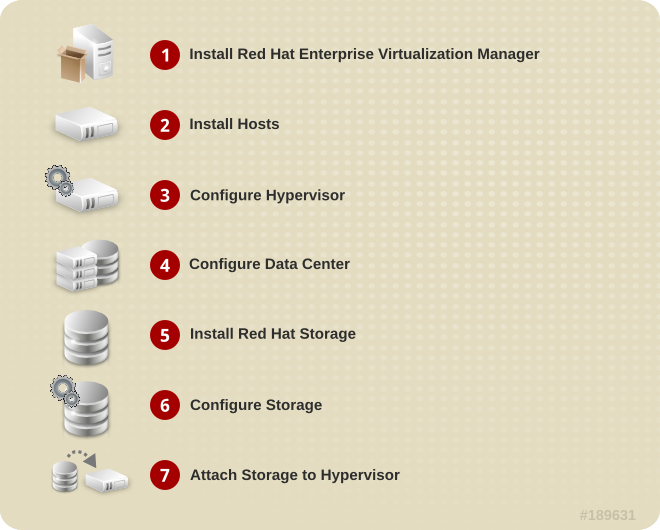-
Language:
English
-
Language:
English
Red Hat Training
A Red Hat training course is available for Red Hat Gluster Storage
Chapter 3. Enabling Red Hat Gluster Storage in Red Hat Enterprise Virtualization Manager
3.1. Using Red Hat Gluster Storage Volumes in the Red Hat Enterprise Virtualization Manager
Red Hat Enterprise Virtualization supports Red Hat Gluster Storage volumes as storage domains. Enabling Red Hat Gluster Storage volumes in Red Hat Enterprise Virtualization Manager requires installation and configuration of several components to create a functioning virtualization environment. You must install and configure each component in the following order:

Figure 3.1. Installation Workflow
Procedure 3.1. To Enable Red Hat Gluster Storage in Red Hat Enterprise Virtualization Manager
Install Red Hat Enterprise Virtualization Manager
The Red Hat Enterprise Virtualization Manager is the control center of the Red Hat Enterprise Virtualization environment. Ensure that Red Hat Enterprise Virtualization Manger is installed and configured.Install and configure Red Hat Enterprise Virtualization Manager. See Installing the Red Hat Enterprise Virtualization Manager in the Red Hat Enterprise Virtualization Installation Guide for more information: https://access.redhat.com/documentation/en-US/Red_Hat_Enterprise_Virtualization/3.6/html/Installation_Guide/part-Installing_Red_Hat_Enterprise_Virtualization.html.Install Hosts
Install the virtual machine hosts using either Red Hat Enterprise Virtualization Hypervisor or Red Hat Enterprise Linux as hosts. Before beginning the installation process, ensure that all virtualization hosts meet the hardware requirements and that the installation of Red Hat Enterprise Virtualization Manager is complete.You can use the following hypervisors as hosts:- Red Hat Enterprise Virtualization Hypervisor 3.4
- Red Hat Enterprise Linux 6.3
- Red Hat Enterprise Linux 6.4
- Red Hat Enterprise Linux 6.5
During installation, set the fully qualified domain name (FQDN) and IP address for the server in order to avoid network conflicts. For information on installing the hypervisor, see Installing Hypervisor Hosts in the Red Hat Enterprise Virtualization Installation Guide: https://access.redhat.com/documentation/en-US/Red_Hat_Enterprise_Virtualization/3.6/html/Installation_Guide/part-Installing_Hypervisor_Hosts.html.Note
You must install Red Hat Enterprise Linux 6.3, Red Hat Enterprise Linux 6.4 Server or Red Hat Enterprise Linux 6.5 on a system to use it as a virtualization host in a Red Hat Enterprise Virtualization environment. See Installing Red Hat Enterprise Linux Hosts in the Red Hat Enterprise Virtualization Installation Guide for details: https://access.redhat.com/documentation/en-US/Red_Hat_Enterprise_Virtualization/3.6/html/Installation_Guide/chap-Red_Hat_Enterprise_Linux_Hosts.html.Subscribe hosts to channels or repositories
Red Hat Enterprise Linux hosts need to be registered and subscribed to a number of entitlements using either Subscription Manager or Red Hat Network Classic. For more information, see Subscribing to Required Channels using RHN Classic in the Red Hat Enterprise Virtualization Installation Guide: https://access.redhat.com/documentation/en-US/Red_Hat_Enterprise_Virtualization/3.6/html/Installation_Guide/Subscribing_to_Required_Channels_using_Subscription_Manager1.html.Subscribe Red Hat Enterprise Linux 6.3, 6.4, and 6.5 hosts to the channels listed below:- rhel-x86_64-server-6
- rhel-x86_64-rhev-mgmt-agent-6
Apart from the above channels, you must also subscribe to the Red Hat Gluster Storage 3.1 Native Client channels to get the latest version:Run therhn-channel --add --channelcommand to subscribe the system to the correct Red Hat Gluster Storage Native Client channel:- For Red Hat Enterprise Linux 7.x clients using Red Hat Satellite Server:
# rhn-channel --add --channel= rhel-x86_64-server-rh-common-7
- For Red Hat Enterprise Linux 6.x clients:
# rhn-channel --add --channel=rhel-x86_64-server-rhsclient-6
- For Red Hat Enterprise Linux 5.x clients:
# rhn-channel --add --channel=rhel-x86_64-server-rhsclient-5
For information on how to install native clients, see Installing Native Client in the Red Hat Gluster Storage Administration Guide: https://access.redhat.com/documentation/en-US/Red_Hat_Storage/3.1/html/Administration_Guide/chap-Accessing_Data_-_Setting_Up_Clients.html#Installing_Native_ClientConfigure the Hypervisor
- Red Hat Enterprise Virtualization Hypervisor host
- Install Red Hat Enterprise Virtualization Hypervisor 3.4 on bare metal. See Installing the Red Hat Enterprise Virtualization Hypervisor chapter of the Red Hat Enterprise Virtualization Installation Guide: https://access.redhat.com/documentation/en-US/Red_Hat_Enterprise_Virtualization/3.6/html/Installation_Guide/part-Installing_Hypervisor_Hosts.html
- Red Hat Enterprise Linux 6.3, 6.4, or 6.5 host
- A Red Hat Enterprise Linux virtualization host must be registered and subscribed to a number of entitlements using either Subscription Manager or Red Hat Network Classic. See Subscribing to Required Channels using RHN Classic in the Installing Red Hat Enterprise Linux Hosts chapter of the Red Hat Enterprise Virtualization Installation Guide for more information.Subscribe to the Red Hat Gluster Storage Native Client from the Additional Services Channels to ensure the server has the latest clients installed:
#
yum install glusterfs-fuse glusterfsFor more information, see Installing Native Client in the Red Hat Gluster Storage Administration Guide: https://access.redhat.com/documentation/en-US/Red_Hat_Enterprise_Virtualization/3.6/html/Installation_Guide/chap-Red_Hat_Enterprise_Linux_Hosts.html.
Configure the data centers
Define data centers and clusters to organize the virtualization hosts. The installation process creates a data center and associated cluster namedDefault.Note
A server can be a Red Hat Enterprise Virtualization Hypervisor or a Red Hat Enterprise Linux host. A trusted storage pool requires a minimum of one storage host, and at least one active virtualization host is required to connect the system to a storage pool.Install Red Hat Gluster Storage
Install the latest version of Red Hat Gluster Storage on the system.For more information on obtaining and installing the software, see the Red Hat Gluster Storage Installation Guide: https://access.redhat.com/documentation/en-US/Red_Hat_Storage/3.1/html/Installation_Guide/chap-Installing_Red_Hat_Storage.html.Configure Storage
Configure the Red Hat Gluster Storage installation for your requirements.For instructions on creating a Red Hat Gluster Storage Volume, see chapter Red Hat Gluster Storage Volume in the Red Hat Gluster Storage Administration Guide: https://access.redhat.com/documentation/en-US/Red_Hat_Storage/3.1/html/Administration_Guide/chap-Red_Hat_Storage_Volumes.html.Red Hat Enterprise Virtualization uses a centralized storage system for virtual machine disk images. Before adding storage, ensure that you have a working Red Hat Enterprise Virtualization Manager environment. You must be able to access the Administration Portal, and there must be at least one host connected with Up status.Note
Red Hat Gluster Storage recommends that you use Replicate or Distributed Replicate volume type for hosting virtual machine disk images.Attach Storage to Hypervisor
Attach the Red Hat Gluster Storage volume as a storage domain.
Now you can create virtual machines and its disk images on the Red Hat Gluster Storage volumes. To optimize the virtual machines on the Red Hat Gluster Storage volumes, see Section 3.2, “Optimizing Virtual Machines On Red Hat Gluster Storage Volumes”

